Guiyang maintains steady economic growth with GDP up 9.3% year-on-year
As indicated by the statistics recently released by Guiyang Municipal Bureau of Statistics, in the first half of 2021 Guiyang's GDP reached RMB204.215 billion, growing by 9.3% year-on-year and 10.8% over the first half of 2019, with an average growth of 5.2% over the past two years.

The three major industries grew rapidly. The added value of the primary industry was RMB8.1billion, up 7.3%, and it grew by 6.0% on a two-year average basis. The added value of the secondary industry rose 10.1% to RMB74.433 billion, putting the two-year average growth at 5.9%. The added value of the tertiary industry was RMB121.682 billion, growing by 9.0% and sending the two-year average growth rate to 4.8%. The added value of the primary, secondary and tertiary industries accounted for 4.0%, 36.4% and 59.6% of the GDP respectively.
Residents' income grew steadily. The per capita disposable income of urban residents was RMB22,885, up 11.1% in nominal terms and 7.5% on average over the first half of 2019; the per capita disposable income of rural residents was RMB9,818, up 14.0% in nominal terms. Compared to the first half of 2019, the two-year average growth rate was 10.4%.
The income of urban and rural residents increased rapidly across the board. The per capita wage income of urban residents, net income from household operation, net income from property and net transfer income were RMB14,086, RMB3,373, RMB2,440 and RMB2,986 respectively, growing by 5.8%, 33.7%, 4.4% and 23.0% year-on-year respectively, and the per capita wage income, net income from household operation, net income from property and net transfer income of rural residents were RMB5,809, RMB2,862, RMB201 and RMB946 respectively, growing by 10.8%, 29.2%, 11.9% and 22.8% respectively over the same period of the previous year.
In the first half of this year, Guiyang made the promotion of new industrialization the top priority of the five-year campaign to increase its primacy as the provincial capital, went all out to strengthen the support for key production factors supply by means of industrial investment attraction and project construction, and made multi-pronged efforts to consolidate the industrial basis. In result, the city's industrial economy has continued to recover and industrial investment has increased rapidly.

Attracting investment to foster increment
Guiyang implements the action plan for large-scale industrial investment attraction to make the investment double within three years, and makes every effort to advance such major activities as leading investment attraction by party and government officials, the special campaign for large-scale investment attraction in Guangdong, and the concentrated signing of contracts with Jiangsu-based businessmen in Guizhou, which has kept up the upsurge in investment attraction. In the first half of this year, the city brought in 55 new industrial projects, each worth over RMB 100 million, with a total investment of over RMB 50 billion, and the total investment for industrial projects exceeded RMB 40 billion, accounting for 51% of city's investment funds attracted.
Strengthening construction to expand investment
Guiyang has put in place a hierarchical service dispatching mechanism for key projects, providing guarantee services for industrial projects each worth RMB 100 million at the municipal level and all-round services for industrial projects at the district level. In the first half of this year, industrial investment increased by 28.8% year-on-year, accounting for 17.3% of all the fixed investment in the city, registering a year-on-year increase of 4.3 percentage points; altogether 111 projects started with a total investment of RMB 28.6 billion, with the number of projects and the total investment growing by 117.7% and 80.8% year-on-year respectively; 69 projects were completed with a total investment of RMB 15.8 billion, with the number of projects and total investment growing by 81.6% and 377.5% year-on-year respectively.
Offering greater support for the supply of factor resources
Guiyang makes every effort to enhance support for the supply of key production factors such as capital, energy and land to ensure the introduction, implementation and rapid progress of industrial projects. We try our best to win policy support from the Provincial Department of Industry and Information Technology and the Provincial Energy Bureau among other departments; accelerate major reforms and innovations such as market-oriented electricity trading, direct natural gas supply, and implementation of pilot projects of "standard land"; and recommend a number of promising projects with a solid foundation to be supported with special funds from superior authorities and new industrialization funds. In the first half of this year, the policy-related incentives of RMB 161 million were granted at the municipal and district levels.
Presented by China Daily.
黔ICP备05001922号-3